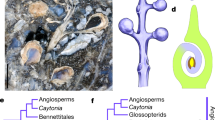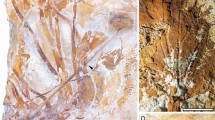Abstract
Over the past 25 years the discovery and study of Cretaceous plant mesofossils has yielded diverse and exquisitely preserved fossil flowers that have revolutionized our knowledge of early angiosperms1, but remains of other seed plants in the same mesofossil assemblages2,3 have so far received little attention. These fossils, typically only a few millimetres long, have often been charred in natural fires and preserve both three-dimensional morphology and cellular detail. Here we use phase-contrast-enhanced synchrotron-radiation X-ray tomographic microscopy to clarify the structure of small charcoalified gymnosperm seeds from the Early Cretaceous of Portugal and North America. The new information links these seeds to Gnetales (including Erdtmanithecales, a putatively closely related fossil group2), and to Bennettitales—important extinct Mesozoic seed plants with cycad-like leaves and flower-like reproductive structures. The results suggest that the distinctive seed architecture of Gnetales, Erdtmanithecales and Bennettitales defines a clade containing these taxa. This has significant consequences for hypotheses of seed plant phylogeny by providing support for key elements of the controversial anthophyte hypothesis, which links angiosperms, Bennettitales and Gnetales.
This is a preview of subscription content, access via your institution
Access options
Subscribe to this journal
Receive 51 print issues and online access
$199.00 per year
only $3.90 per issue
Buy this article
- Purchase on Springer Link
- Instant access to full article PDF
Prices may be subject to local taxes which are calculated during checkout



Similar content being viewed by others
References
Friis, E. M., Pedersen, K. R. & Crane, P. R. Cretaceous angiosperm flowers: Innovation and evolution in plant reproduction. Palaeogeogr. Palaeoclimatol. Palaeoecol. 232, 251–293 (2006)
Pedersen, K. R., Crane, P. R. & Friis, E. M. Pollen organs and seeds with Eucommiidites pollen. Grana 28, 279–294 (1989)
Rydin, C., Pedersen, K. R., Crane, P. R. & Friis, E. M. Former diversity of Ephedra (Gnetales): evidence from Early Cretaceous seeds from Portugal and North America. Ann. Bot. (Lond.) 98, 123–140 (2006)
Doyle, J. A. Seed ferns and the origin of angiosperms. J. Torrey Bot. Soc. 133, 169–209 (2006)
Hilton, J. & Bateman, R. M. Pteridosperms are the backbone of seed-plant phylogeny. J. Torrey Bot. Soc. 133, 119–168 (2006)
Bateman, R. M., Hilton, J. & Rudall, P. J. Morphological and molecular phylogenetic context of the angiosperms: contrasting the ‘top-down’ and ‘bottom-up’ approaches used to infer the likely characteristics of the first flowers. J. Exp. Bot. 57, 3471–3503 (2006)
Donoghue, P. C. J. et al. Synchrotron X-ray tomographic microscopy of fossil embryos. Nature 442, 680–683 (2006)
Tafforeau, P. et al. Applications of X-ray synchrotron microtomography for non-destructive 3D studies of paleontological specimens. Appl. Phys. A 83, 195–202 (2006)
Tafforeau, P., Bentaleb, I., Jaeger, J. J. & Martin, C. Nature of laminations and mineralization in rhinoceros enamel using histology and X-ray synchrotron microtomography: Potential implications for palaeoenvironmental isotopic studies. Palaeogeogr. Palaeoclimatol. Palaeoecol. 246, 206–227 (2007)
Friis, E. M., Pedersen, K. R. & Crane, P. R. Angiosperm floral structures from the Early Cretaceous of Portugal. Plant Syst. Evol. 8 (suppl.). 31–49 (1994)
Thoday, M. G. The female Inflorescence and ovules of Gnetum africanum, with notes on Gnetum scandens . Ann. Bot. (Lond.) 25, 1101–1135 (1911)
Berridge, E. M. On some points of resemblance between Gnetalean and Bennettitean seeds. New Phytol. 10, 140–144 (1911)
Pearson, H. H. W. Gnetales (Cambridge Univ. Press, Cambridge, 1929)
Martens, P. Handbuch der Pflanzenanatomie, vol. 12, pt 2:Les gnétophytes (eds Zimmermann, W., Carlquist, S., Ozenda, P. & Wulff, H. D.) (Gebrüder Borntraeger, Berlin, Stuttgart, 1971)
Yang, Y., Geng, B.-Y., Dilcher, D. L., Chen, Z.-D. & Lott, T. A. Morphology and affinities of an Early Cretaceous Ephedra (Ephedraceae) from China. Am. J. Bot. 92, 231–241 (2005)
Harris, T. M. The fossil flora of Scoresby Sound East Greenland. Part 3: Caytoniales and Bennettitales. Medd. Grønl. 85, 1–133 (1932)
Pedersen, K. R., Crane, P. R. & Friis, E. M. Morphology and phylogenetic significance of Vardekloeftia Harris (Bennettitales). Rev. Palaeobot. Palynol. 60, 7–24 (1989)
Stopes, M. C. New Bennettitean cones from the British Cretaceous. Phil. Trans. R Soc. B 208, 389–440 (1918)
Rothwell, G. W. & Stockey, R. A. Anatomically preserved Cycadeoidea (Cycadeoidaceae), with a reevaluation of systematic characters for the seed cones of Bennettitales. Am. J. Bot. 89, 1447–1458 (2002)
Crane, P. R. Phylogenetic analysis of seed plants and the origin of angiosperms. Ann. Mo. Bot. Gard. 72, 716–793 (1985)
Lignier, O. Végétaux fossiles de Normandie. Structure et affinités du Bennettites morierei Sap. & Mar. (sp.) 1–78 (E. Lanier, Caen, 1894)
Doyle, J. A., Donoghue, M. J. & Zimmer, E. A. Integration of morphological and ribosomal RNA data on the origin of angiosperms. Ann. Mo. Bot. Gard. 81, 419–450 (1994)
Arber, E. A. N. & Parkin, J. On the origin of angiosperms. J. Linn. Soc. Bot. 38, 29–80 (1907)
Burleigh, J. G. & Mathews, S. Phylogenetic signal in nucleotide data from seed plants: implications for resolving the seed plant tree of life. Am. J. Bot. 91, 1599–1613 (2004)
Groso, A., Abela, R. & Stampanoni, M. Implementation of a fast method for high resolution phase contrast tomography. Opt. Express 14, 8103–8110 (2006)
Bronnikov, A. V. Reconstruction formulas in phase-contrast tomography. Opt. Commun. 171, 239–244 (1999)
Cloetens, P. et al. Holotomography: Quantitative phase tomography with micrometer resolution using hard synchrotron radiation X rays. Appl. Phys. Lett. 75, 2912–2914 (1999)
Weitkamp, T. et al. X-ray phase imaging with a grating interferometer. Opt. Express 13, 6296–6304 (2005)
Bronnikov, A. V. Theory of quantitative phase-contrast computed tomography. J. Opt. Soc. Am. A 19, 472–480 (2002)
Gureyev, T. E., Paganin, D. M., Myers, G. R., Nesterets, Y. I. & Wilkins, S. W. Phase-and-amplitude computer tomography. Appl. Phys. Lett. 89, 034102–1–034102-3 (2006)
Acknowledgements
We thank F. Marone of the Swiss Light Source for valuable help in setting up the software on the cluster, and T. Huldtgren and N. J. Gostling for help with data analyses. We also thank the Natural History Museum, London, for the loan of petrified specimens, J.-P. Rioult for information on the Lignier fossils, and J. Hilton for helpful suggestions. This study was funded by the Swiss Light Source (P.C.J.D. and S.B.), European Union FP6, as well as by grants from the Swedish Research Council (E.M.F.), the Carlsberg Foundations (K.R.P. and E.M.F.) and the National Science Foundation (P.R.C.).
Author information
Authors and Affiliations
Corresponding authors
Supplementary information
Supplementary Information
The file contains Supplementary Notes, Supplementary Figures S1-S2 with Legends and Supplementary Tables 1-3. Supplementary Notes include supporting data for the charcoalified fossils; anatomical comparison between the charcoalified seeds and extinct Bennettitales; cladistic analysis expanding the Hilton and Bateman data matrix and additional references. (PDF 1884 kb)
Supplementary Video 1
The file contains Supplementary Video 1 with the reconstructed slice data for specimen S153152 showing transverse sections. (MOV 42932 kb)
Supplementary Video 2
The file contains Supplementary Video 2 with the reconstructed slice data for specimen S153152 showing longitudinal sections. (MOV 30111 kb)
Rights and permissions
About this article
Cite this article
Friis, E., Crane, P., Pedersen, K. et al. Phase-contrast X-ray microtomography links Cretaceous seeds with Gnetales and Bennettitales. Nature 450, 549–552 (2007). https://doi.org/10.1038/nature06278
Received:
Accepted:
Issue Date:
DOI: https://doi.org/10.1038/nature06278
This article is cited by
-
Mesozoic cupules and the origin of the angiosperm second integument
Nature (2021)
-
Sixty-one thousand recent planktonic foraminifera from the Atlantic Ocean
Scientific Data (2018)
-
Staminate flower of Prunus s. l. (Rosaceae) from Eocene Rovno amber (Ukraine)
Journal of Plant Research (2018)
-
The diversity of Australian Mesozoic bennettitopsid reproductive organs
Palaeobiodiversity and Palaeoenvironments (2018)
-
Palaeobotanical redux: revisiting the age of the angiosperms
Nature Plants (2017)
Comments
By submitting a comment you agree to abide by our Terms and Community Guidelines. If you find something abusive or that does not comply with our terms or guidelines please flag it as inappropriate.



